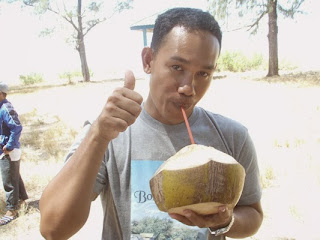We came ashore at Sagori Island and walked across the island to the north shore. The police launch was dropping off folks to come ashore from another island.
The lagoon side of Sagori. That tiny white spec in the middle is YOLO anchored out in the lagoon. It's smooth now, but in the afternoons it got pretty wild out there.
Karen and Jason with the paddles we were presented with; they represent the wish that we should be able to return to this island some day. They were all made by hand by the village carpenter. They had remnants of paint on them, so I suspect they were carved from planks from someone's old home??
The oldest folks on the island are preparing a blessing for us. They mixed up a concoction from leaves and other stuff and our representative had to sip it. They also tied a flag that was the shape of a person to a tall bamboo pole and presented it to our rep. She had to request to leave the pole behind but took the flag to be polite.
The street of Sagori. It's all sand.
Preparing coconuts for us to drink.
The English translanter enjoying a coconut drink. They really are refreshing, but these huge coconuts were so heavy that it took two hands for me to drink mine.
Some of the food at our lunch on Sagori. The little husk-wrapped goodies in the foreground were rice and palm sugar, a sweet treat that locals carry with them for a goodie on the go.
A square piece of seaweed on the sand. It is only about a half inch square, but I've drunk several drinks where these things are included. I never knew seaweed came in clear cubes like this! Very bizarre.
These sputnik-looking grass flowers grew on this dry island. There is no source of water on Sagori.
A home on Sagori. They are all raised off the ground on poles for cooling and to keep the water out if the waves get too high.
We took the police launch from Sagori across the strait to Sekeli to see these school children dance their stick dances. I don't know the official name, but these kids were impressive. They didn't miss a step! The bamboo poles moved in two different directions and at a very fast pace and they had to dance their steps between the poles.
Different dancers and poles but the same deftness of foot was required.
His catch of the day so far....
Another home on the beach at Sekeli. These homes were just behind the tents of food and crafts that they'd set up for us rally visitors.
Stick handlers waiting for their turn to show off their skills. The white on the poles is pieces of paper wrapped around the bamboo to make them look special. When I looked closely at the paper, it was the back side of printed materials. At least its getting recycled.
More school dancers waiting to strut their stuff for us.
Stirring the palm sugar while it boils down in this hut. There is a pit below the pan with logs burning in it to heat the sugar.
The palm sugar processing hut.
Straining out the palm sugar sap from the bamboo container that is used to collect it. I swear the stuff used to strain it looked like a wad of horse hair, but someone told me it was part of a palm tree....hmmmm, I'm not sure I believe that.
The palm sugar water is a clear sweet liquid when tapped from the tree.
Once it has boiled down, the palm sugar is put into the coconut shell halves and left for a few days to cool and harden. Then it is wrapped in husks, two to a husk and tied off at both ends to be sold.
The village leaders at Tangkeno, the eco village in the clouds.
They made speeches and gave us a blessing.
These women brandished some sharp knives and the banana stalk was cut down in a symbolic gesture during one of their traditional dances.
Love the pointy hats. Reminded me of the wicked witch of the west, but in more color.
The school children played songs for us on their bamboo instruments.
Bamboo in different lengths and diameters make different sounds and these kids played instruments we'd never seen before.
Cute musical troop, eh?A view of the peaks that we could also see from the boats. They say you can see the three peaks from any angle. If the peaks are in the clouds, the wind and waves will be rough on the seas. If clear, the seas will be calm.
View of the peak from Tangkeno
Tangkeno buildings. Notice how red the soil is.
Local musicians with bamboo instruments. One was like a xylophone and the other was like bamboo logs laid next to each other. They invited us to try to play them, but only a couple of folks had any musical talent to try.Our lunch laid out for us in the community house at Tangkeno.
That's Jason in the red hat, eating lunch. We all sat on the floor and ate. No shoes allowed inside the buildings.
After lunch, some walked 1.5km up the hillside to see the remains of an old Dutch outpost or fort. Slabs of stone piled to make walls way up on this mountain. I didn't make the hike and some of these photos are courtesy of Zdenka from Kite.
YOLO surrounded by some of the local boats who came into the lagoon to say goodbye to the rally boats before we left. They were very colorful and swarmed around us waving and shouting for half an hour or more.
This guy followed YOLO all the way out of the lagoon and around the other side of the island. I finally tossed him a couple of t-shirts in a plastic bag to reward him for his colorful efforts.










































